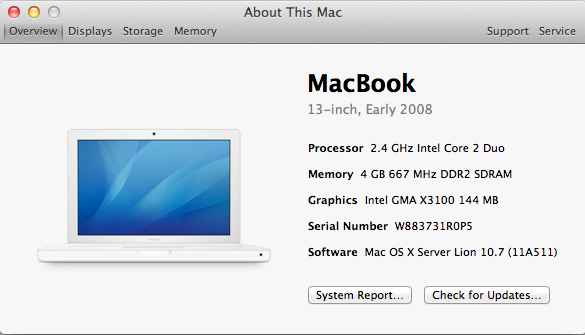In-Depth with Mac OS X Lion Server
by Andrew Cunningham on August 2, 2011 8:00 AM ESTLike the client version of Lion, Lion Server is now a download from the Mac App Store, and as with Lion client this means that there are some changes in the installation process.
A server upgrade install from Snow Leopard Server is performed the same way as a client upgrade install - fire up the App Store, download the installer, and let it do its thing. If you’re running the upgrade from a Snow Leopard server, the App Store is smart enough to prompt you to buy the Server app if you haven’t already. You can also convert any Lion client install to a server install by downloading the Server app from the App Store, and then running it - it will download and install some additional components, and the next time you reboot your Lion client, it’ll be a server instead.

Don't make fun of my test server, okay?
Upgraders should note that OS X Server upgrades tend not to go as smoothly as their client counterparts, and the App Store reviews for Lion Server indicate that this hasn’t changed - if you haven’t already backed up all the data that’s important to you (including a full-disk backup of the hard drive, if you can), make sure you do it before you upgrade. I would recommend doing a clean install if you can, but your mileage may vary - just know that the more you’ve customized Snow Leopard Server, the more likely the upgrade is to break something.
Interestingly, Lion Server removes Snow Leopard Server’s requirement that the software be installed on a desktop Mac system - if, for whatever reason, you want to use a laptop as a server, you can do it without any workarounds. I would generally recommend against this except in light-use or home-use scenarios, since slow-spinning 5400 RPM drives and higher heat are going to give you less-than-stellar performance in workloads that require lots of disk usage - the ability to install Lion Server on a laptop is more useful for remote management of a desktop server, which we’ll talk a little bit about in the next section.










77 Comments
View All Comments
Kristian Vättö - Tuesday, August 2, 2011 - link
Your Twitter was right, this really is endlessCharonPDX - Tuesday, August 2, 2011 - link
It was that pesky loop that started on page 23 that circled you back to page 8. By the time you'd read page 23, you'd forgotten what was on page 8, so you didn't notice you were in a loop until you were at what you thought was page 157...B3an - Tuesday, August 2, 2011 - link
Very in depth article... but i feel you've wasted time on this. No one in there right mind would use OSX as a server. Apart from Apple fanboys that choose an inferior product over better alternatives because it has an Apple logo, but i emphasize the words "right mind".FATCamaro - Tuesday, August 2, 2011 - link
For enterprise work, or a Windows-only network this is certainly true. For SMB, or even 500 mac/mixed users I think it could work if you can provide some glue to handle fail-over.Windows server is better for Office for sure as is Linux for web & applications.
Spivonious - Wednesday, August 3, 2011 - link
I can run a web server on the client version of Windows. It's just not installed by default.mino - Saturday, August 6, 2011 - link
Hint: for how many users/connections ....If it was THAT simple there would be no Web Edition, mind you.
AlBanting - Friday, August 19, 2011 - link
Same thing for client version of Mac OS X. I've done this for years.KPOM - Tuesday, August 2, 2011 - link
True, for an enterprise user. However, a small business or tech-savvy home user trying to manage multiple Windows PCs, Macs, and iOS devices might well be tempted by the $50 price tag.If should be obvious by the price drop and the discontinuation of the XServe that Apple no longer intends to compete with Windows Server or Linux in the enterprise market. They are a consumer-oriented company, and released a server OS intended for a consumer market.
zorxd - Tuesday, August 2, 2011 - link
Tech-savvy home user will run a free linux distro for a server. Plus it will work on any hardware, not only on a Mac. Many use older PCs as servers.Also the Mac Pro is too expensive and the Mac Mini can't even have 3.5" drives which mean that it is a bad solution for a file server.
richardr - Tuesday, August 2, 2011 - link
Actually, I have a real use case, though it may be a bit specialised for your tastes... non-computing departments of universities are full of people with underused desktops running Word, but also have other people doing analyses that take ages to run on their machines. Making them all Macs (you'll never persuade them to use linux) and wiring them up with xgrid and OSX Server is a pretty pain-free way of running my analyses on their machines without too much disruption to their lives...